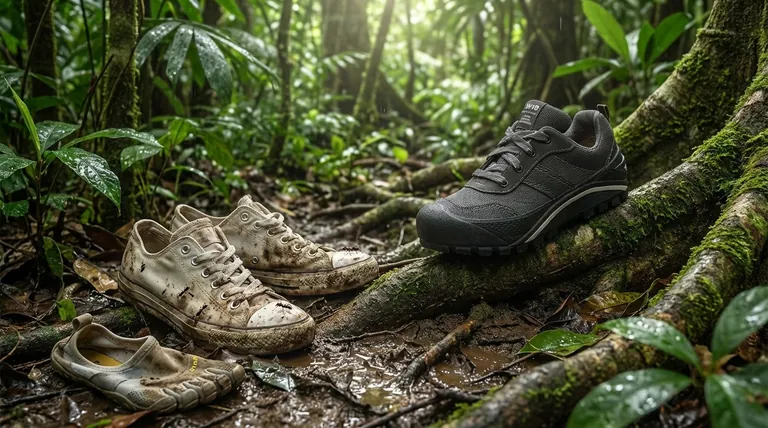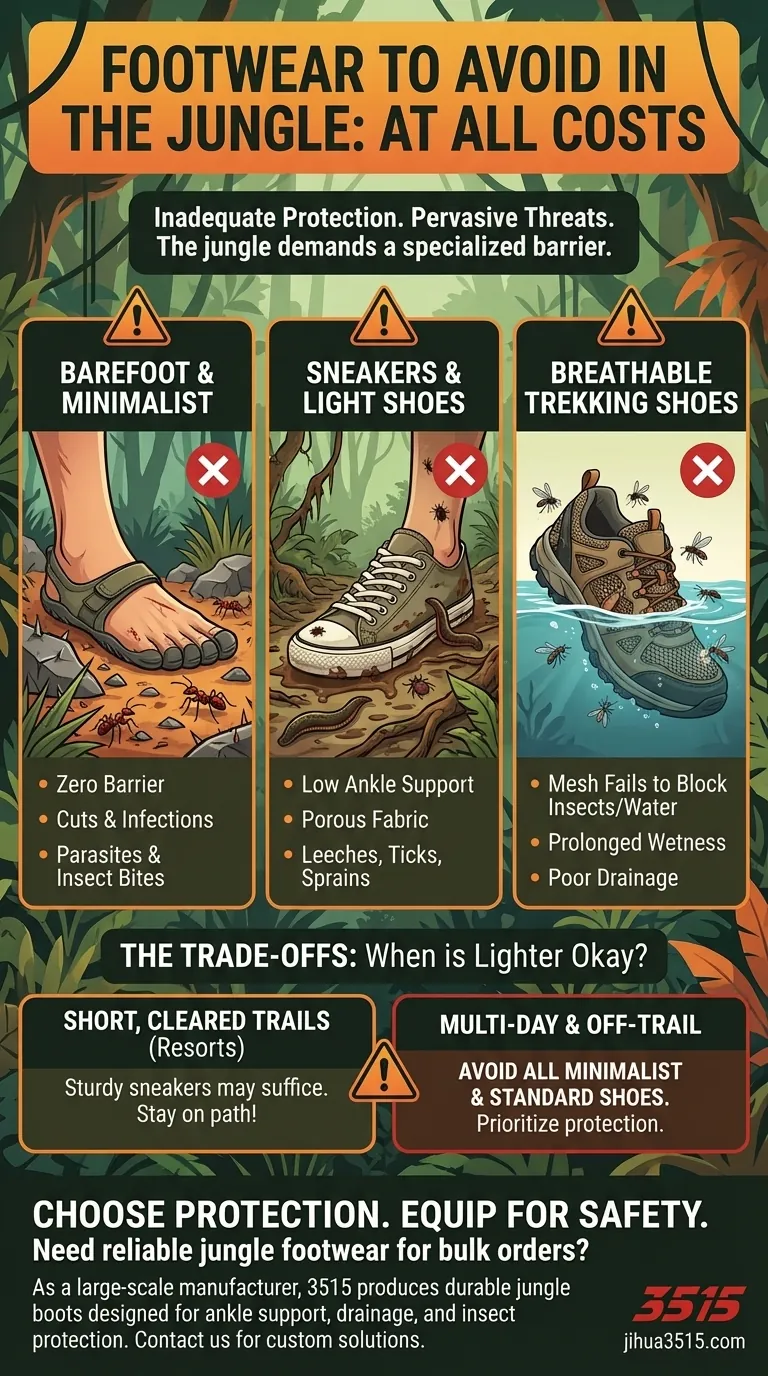At all costs, you must avoid walking barefoot, using minimalist footwear like "five-finger" shoes, or wearing standard sneakers and most consumer trekking shoes for any serious jungle activity. These options provide fundamentally inadequate protection from the jungle's unique and pervasive environmental threats, exposing your feet to insects, injury, and constant moisture without the necessary support or durability.
The core challenge of jungle footwear isn't just about comfort—it's about creating an impenetrable barrier. The wrong choice leaves you vulnerable to the ground-level hazards that define this environment, while the right choice provides the protection and stability needed to move with confidence.

Why Standard Footwear Fails in the Jungle
The principles of choosing footwear for mountains or dry trails do not apply to the jungle. The environment is uniquely aggressive, requiring a specialized approach that prioritizes protection and water management over lightweight breathability.
The Danger of Minimalist Footwear
Walking barefoot or using "Vibram-style" five-finger shoes is exceptionally dangerous. This approach offers virtually no barrier between your skin and the environment.
Your feet are completely exposed to sharp rocks, thorns, and biting insects like fire ants and scorpions. More seriously, it opens the door to parasites and infections from soil and contaminated water.
The Inadequacy of Sneakers and Light Shoes
Standard sneakers or "tiny tennis shoes" are unsuitable for jungle trekking. Their low-cut design offers zero ankle support on the uneven, root-covered, and often muddy jungle floor.
Furthermore, their soft, porous fabric is an open invitation for ants, ticks, leeches, and other creatures to bite or attach themselves directly to your skin.
When Breathable Trekking Shoes Become a Liability
Even more robust trekking shoes, popular for their breathability, often fall short. While excellent for dry climates, their breathable mesh panels can be a significant weakness in the jungle.
These materials do not stop the bites of determined insects and offer little resistance to leeches. They also become saturated with water quickly during river crossings or downpours and lack the drainage systems of true jungle boots, leading to prolonged wetness.
Understanding the Trade-offs
The suitability of footwear is directly related to the intensity of the activity. There is a distinction between a casual walk and a true expedition.
When Might Lighter Shoes Be Acceptable?
For very short walks on wide, cleared, and predictable trails—such as those found in a resort or a well-managed national park—a pair of sturdy sneakers or light trekking shoes may suffice.
In these controlled settings, the risk of encountering severe hazards is significantly lower, though it is never zero.
The Hidden Risks of Under-Preparing
The jungle is an unpredictable environment. A trail that starts clear can quickly degrade, and a single misstep off the path can expose you to the full range of hazards.
Choosing footwear based on the "best-case scenario" is a significant gamble. The consequences of inadequate protection, from debilitating insect bites to a sprained ankle, can quickly escalate a minor issue into a serious problem far from help.
Making the Right Choice for Your Goal
Your footwear choice should be a direct reflection of your activity and your tolerance for risk. To ensure safety and effectiveness, match your gear to the environment you will actually be in, not the one you hope for.
- If your primary focus is a short, highly-maintained trail walk: Sturdy sneakers or light trekking shoes can be adequate, but you must remain vigilant and stay on the designated path.
- If your primary focus is multi-day trekking or off-trail exploration: You must avoid all minimalist footwear, sneakers, and standard trekking shoes in favor of specialized jungle or military-style boots designed for protection and water drainage.
- If your primary focus is maximum safety regardless of the activity: Always default to a proper boot that provides full coverage, ankle support, and a non-porous exterior.
Ultimately, proper footwear is not about enduring the jungle; it is about equipping yourself to operate within it safely and effectively.
Summary Table:
| Footwear Type | Why It's Unsafe | Key Risks |
|---|---|---|
| Barefoot / Minimalist Shoes | Zero barrier from ground hazards | Cuts, parasites, insect bites, infections |
| Sneakers / Light Shoes | Low ankle support, porous fabric | Ankle sprains, leeches, ticks, ants |
| Breathable Trekking Shoes | Mesh panels fail to block insects/water | Leeches, prolonged wetness, poor drainage |
Need reliable jungle footwear for bulk orders?
As a large-scale manufacturer, 3515 produces a comprehensive range of durable, protective jungle boots designed for distributors, brand owners, and bulk clients. Our footwear is engineered to provide the ankle support, water drainage, and insect protection essential for safe jungle exploration.
Contact us today to discuss your custom footwear needs and ensure your clients are properly equipped for any environment.
Get a Quote & Discuss Your Project
Visual Guide

Related Products
- Durable Rubber Sole Outdoor Shoes Wholesale & Custom Manufacturing
- Safety Footwear Wholesale Manufacturer for Custom OEM/ODM Production
- Wholesale Safety Footwear Manufacturer for Bulk & Custom OEM Orders
- Premium Flame-Retardant Waterproof Safety Boots and Shoes
- Premium Insulated Safety Boots and Shoes for Wholesale & Bulk Orders
People Also Ask
- How do hiking shoes or boots protect feet from environmental hazards? A Guide to Trail-Ready Footwear
- What are the disadvantages of vulcanized soles? Lack of Support & Durability Explained
- Why are rubber-soled shoes considered multi-weather footwear? Unlock All-Season Traction & Protection
- Why are vulcanized soles popular in urban fashion? Discover the Legacy of Authentic Street Style
- What should be considered when choosing hiking boots for snake protection? Prioritize Fit & Materials for Safety



















